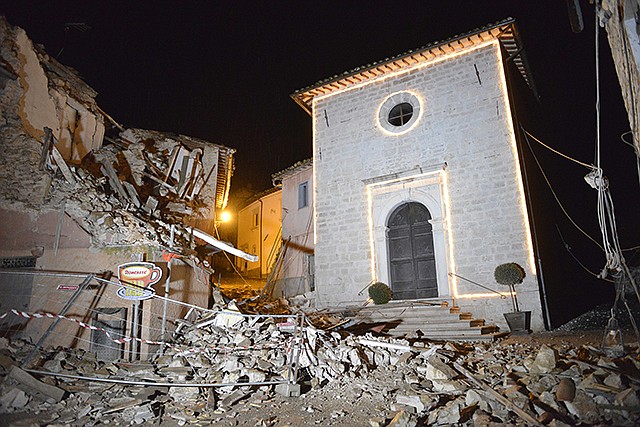ROME (AP) - A pair of strong aftershocks shook central Italy late Wednesday, crumbling churches and buildings, knocking out power and sending panicked residents into the rain-drenched streets just two months after a powerful earthquake killed nearly 300 people.
One person was injured in the epicenter of Visso, where the rubble of collapsed buildings tumbled into the streets. However, the Civil Protection agency, which initially reported two injured, had no other immediate reports of injuries or deaths.
The first quake carried a magnitude of 5.4, but the second one was eight times stronger at 6.1, according to the U.S. Geological Survey. Because many residents had already left their homes after the first one struck at 7:10 p.m., with plans to spend the night in their cars or elsewhere, they weren't home when the second one hit two hours later, possibly saving lives, news reports said.
"It was an unheard-of violence. Many houses collapsed," Ussita Mayor Marco Rinaldi told Sky TG24. "The facade of the church collapsed. By now I have felt many earthquakes. This is the strongest of my life. It was something terrible."
Rinaldo said two elderly people were rescued from their home, where they were trapped. He said they appeared to be in good condition. Some 200 people in Ussita will sleep in the streets, given the impossibility of putting up tents in the night.
Calling it "apocalyptic," he said the town and its hamlets were "finished." "People are screaming on the street and now we are without lights."
A church crumbled in the ancient Perugian town of Norcia, famed for its Benedictine monastery and its cured meats. A bell-tower damaged on Aug. 24 fell and crushed a building in Camerino, the ANSA news agency said. Elsewhere, buildings were damaged, though many were in zones declared off-limits after the Aug. 24 quake that flattened parts of three towns.
"We're without power, waiting for emergency crews," said Mauro Falcucci, the mayor of Castelsantangelo sul Nera, near the epicenter. Speaking to Sky TG24, he said: "We can't see anything. It's tough. Really tough."
He said some buildings had collapsed, but that there were no immediate reports of injuries in his community. He added darkness and a downpour were impeding a full accounting.
Schools were closed in several towns Thursday as a precaution.
Italy's national vulcanology center said the first quake struck at 7:10 p.m. local time with an epicenter in the Macerata area, near Perugia in the quake-prone Apennine Mountain chain. The U.S. Geological Survey put the epicenter near Visso, 100 miles northeast of Rome, and said it had a depth of some 6 miles.
The second aftershock struck two hours later at 9:18 p.m. with a similar depth.
Experts said even relatively modest quakes that have shallow depths can cause significant damage because the seismic waves are closer to the surface. However, seismologist Gianluca Valensise said a depth is within the norm for an Apennine temblor.
The Aug. 24 quake that destroyed the hilltop village of Amatrice and other nearby towns had a depth of about 6 miles. Amatrice Mayor Sergio Pirozzi said residents felt Wednesday's aftershocks, but "We are thanking God that there are no dead and no injured."
Wednesday's temblors were felt from Perugia in Umbria to the capital Rome as far north as Veneto. It also shook the central Italian city of L'Aquila, which was struck by a deadly quake in 2009. The mayor of L'Aquila, however, said there were no immediate reports of damage there.
A section of a major state highway north of Rome, the Salaria, was closed near Arquata del Tronto as a precaution because of a quake-induced landslide, said a spokeswoman for the civil protection agency, Ornella De Luca.
In Rome, some 145 miles southwest from the epicenter, centuries-old palazzi shook and officials at the Foreign Ministry evacuated the building.

